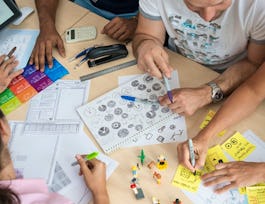Course 5 examines the role of anthropometrics, biomechanics and motor skills in human performance as well as key factors that influence how humans produce and sense motion, and how these can be applied to training and testing performance.



Anthropometry, Biomechanics, and Motor Skills in User Design
This course is part of Human Factors & Usability Engineering: Designing for Humans Specialization

Instructor: Robert Gray
Sponsored by EdgePoint Software
Recommended experience
What you'll learn
You will be introduced to types of controls, be able to understand and identify key factors that influence how humans produce & sense motion.
Details to know

Add to your LinkedIn profile
4 assignments
See how employees at top companies are mastering in-demand skills

Build your subject-matter expertise
- Learn new concepts from industry experts
- Gain a foundational understanding of a subject or tool
- Develop job-relevant skills with hands-on projects
- Earn a shareable career certificate


Earn a career certificate
Add this credential to your LinkedIn profile, resume, or CV
Share it on social media and in your performance review

There are 5 modules in this course
This course explores anthropometry, biomechanics, and motor skills. You will learn about measuring human body dimensions and characteristics, known as anthropometrics, and how these measurements are used in design. The course covers factors influencing motion production and perception, including open- and closed-loop control and stimulus-response compatibility. You will also explore the applications of motion-tracking technologies in training and testing human performance.
What's included
1 video1 reading
Module 1 explores anthropometry and ergonomics, covering the measurement of human body dimensions and the importance of anthropometric data in fields like product design and workspace layout. The module also focuses on ergonomics, the science of designing products and environments to fit human capabilities and enhance safety and efficiency. You will learn about the principles and goals of ergonomics, as well as ergonomic design considerations for creating user-centered products and workspaces.
What's included
3 videos6 readings1 assignment1 discussion prompt
In Module 2, we dive into the realm of ergonomics research, exploring various applications in different settings. We begin with Lesson 1, focusing on office design and exercise, aiming to create the perfect ergonomic workspace. Moving on to Lesson 2, we shift our attention to factories and industrial settings. In Lesson 3, we turn our focus to the healthcare sector.
What's included
3 videos6 readings1 assignment1 discussion prompt
In this module, we explore the field of biomechanics, which focuses on studying the mechanics and movement of the human body. We will cover various aspects of biomechanics, including its definition, applications in different domains, and methods for analyzing human movement. By the end of this module, you will have a solid understanding of biomechanics principles and how they are used to study and analyze human motion.
What's included
3 videos6 readings1 assignment1 discussion prompt
Module 4 focuses on the practical applications of biomechanics in various fields. It explores how biomechanics can be utilized to optimize performance, prevent injuries, and enhance movement in sports, rehabilitation, ergonomics, and other contexts.
What's included
3 videos8 readings1 assignment
Instructor

Offered by
Why people choose Coursera for their career




Recommended if you're interested in Physical Science and Engineering

University of North Texas

University of Michigan

University of Minnesota

Open new doors with Coursera Plus
Unlimited access to 10,000+ world-class courses, hands-on projects, and job-ready certificate programs - all included in your subscription
Advance your career with an online degree
Earn a degree from world-class universities - 100% online
Join over 3,400 global companies that choose Coursera for Business
Upskill your employees to excel in the digital economy



